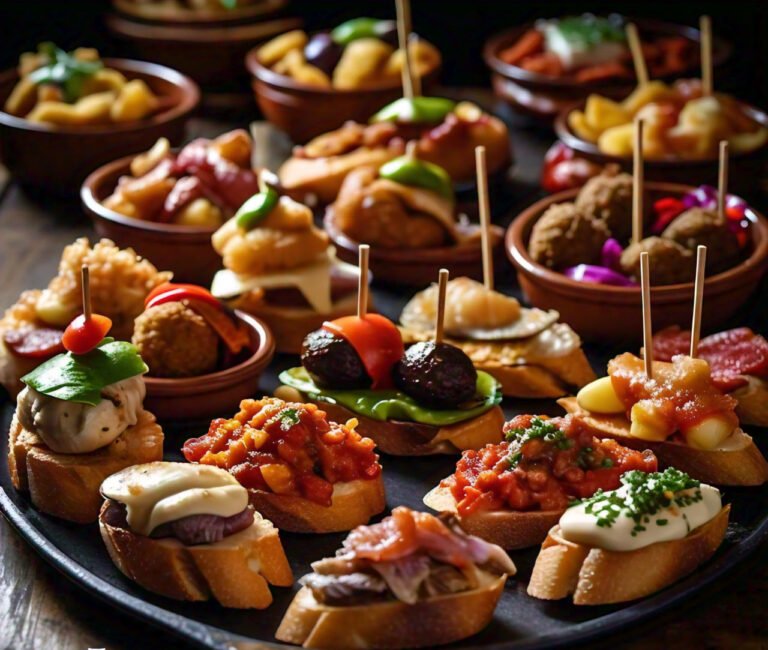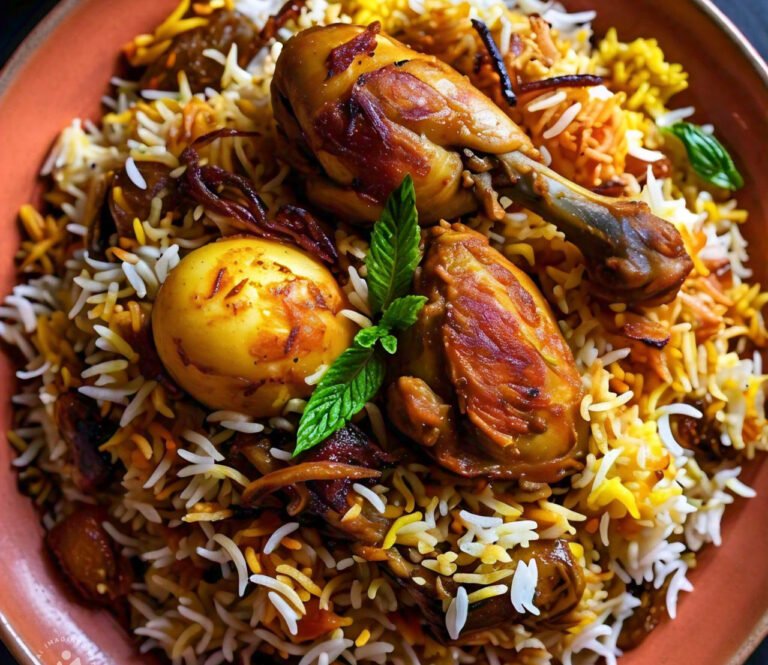Introduction
From “Sushi to Tapas,” a journey through the world’s cuisines is a rich tapestry woven with flavors, colors, and traditions. Each dish reflects not only the unique ingredients of its homeland but also the history, culture, and spirit of the people who created it. This article will take you on a tour of global culinary delights, from Japan’s refined sushi to Spain’s sociable tapas. In each case, we’ll explore how these foods transcend mere taste, creating a sensory experience that embodies the world itself.
1. Sushi: Japan’s Iconic Creation
Sushi, Japan’s celebrated and artfully presented dish, goes beyond being a simple meal—it’s an experience of freshness and balance. Originating centuries ago as a way to preserve fish, sushi evolved over time and gained widespread popularity across the globe. Today, sushi is made by combining vinegared rice with fresh fish, vegetables, or egg, often wrapped in seaweed.
In Japan, sushi is a craft that requires precision, with types like nigiri, where fish is hand-pressed over rice; sashimi, consisting of carefully sliced raw fish; and maki, a rolled sushi variation. With its clean presentation and balanced flavors, sushi reflects Japanese aesthetics and culinary philosophy. For Japanese diners, eating sushi is more than enjoying fresh seafood; it is a connection to their culinary roots, enjoyed in its purest form.
2. Dim Sum: China’s Bite-Sized Treasures
In China, dim sum represents a culinary style filled with warmth and sociability. Traditionally enjoyed with tea, dim sum consists of small plates of dumplings, buns, and rolls with various fillings, often steamed, baked, or fried. Originating from Cantonese cuisine, dim sum embodies the rich textures and flavors of China and is especially popular in Guangdong Province.
Dim sum has evolved into a beloved global phenomenon, enjoyed worldwide in dim sum parlors or through the classic Yum Cha experience, where people gather for tea and small plates. With delicacies like siu mai (open-topped dumplings), baozi (steamed buns), and spring rolls, dim sum provides a blend of flavors that’s light yet satisfying. It’s an inviting introduction to Chinese food, highlighting its diversity in bite-sized portions.
3. Pad Thai: Thailand’s Signature Street Dish
In Thailand, Pad Thai holds a special place as the country’s unofficial national dish. Known for its balance of salty, sweet, sour, and spicy flavors, Pad Thai is made with rice noodles stir-fried with shrimp, chicken, or tofu, and topped with a sprinkling of peanuts. The origins of Pad Thai date back to the 1930s when the Thai government promoted it as a way to create a unique Thai identity.
Today, Pad Thai captures the essence of Thailand’s vibrant street food culture. Every bite reveals a carefully balanced mix of flavors that feels both refreshing and hearty. The sauce’s tangy tamarind and fish sauce, the crunch of fresh vegetables, and the option for a spicy kick make Pad Thai a meal that’s both satisfying and quintessentially Thai.
4. Tapas: Spain’s Social Plates
Tapas, originating from Spain, offer more than just food—they’re a way to socialize and share. Tapas are small portions of various dishes, including meats, seafood, and vegetables, which are typically shared among friends and family. Traditionally, tapas were slices of bread used to cover wine glasses and prevent flies, but they’ve since evolved into a key component of Spanish culture.
Popular tapas like patatas bravas (spicy potatoes), chorizo, and gambas al ajillo (garlic shrimp) vary widely by region, with each area adding its unique twist. Eating tapas is about savoring food at a relaxed pace, enjoying each dish with a different sip of wine, and embracing the communal atmosphere that makes Spanish dining so inviting. In Spain, tapas represent a culture of togetherness and shared enjoyment.
5. Pasta: Italy’s Eternal Classic
No global food journey is complete without a stop in Italy, where pasta reigns supreme. From spaghetti to penne and fettuccine, pasta’s different shapes and textures offer endless variations, each pairing beautifully with Italy’s signature sauces. Whether dressed in marinara, alfredo, or pesto, pasta serves as a comforting, versatile dish that’s beloved worldwide.
Italian pasta is more than a simple meal; it’s a culinary tradition rooted in history. Each region in Italy has its preferred pasta shapes and preparation methods, from the creamy fettuccine alfredo of Rome to the hearty, meat-filled lasagna of Bologna. To Italians, pasta is an expression of warmth and love, often enjoyed as a family gathering meal or during special celebrations, embodying Italy’s passion for life and food.
6. Biryani: South Asia’s Flavorful Feast
In South Asia, biryani holds a place of honor as a richly spiced rice dish layered with marinated meat, often served during festivities. Originally brought to the Indian subcontinent by Persian travelers and traders, biryani has evolved into countless regional varieties, including Hyderabadi, Lucknowi, and Karachi biryani, each with its unique spice blend and cooking method.
Biryani is a feast for the senses, with fragrant basmati rice infused with saffron, spices like cardamom and cloves, and tender meat that has soaked up every flavor. It’s a festive dish enjoyed across cultures, where the act of preparing and serving biryani becomes a communal event. For many, biryani is not just food; it’s a symbol of celebration and hospitality.
7. Moussaka: Greece’s Comforting Casserole
A trip to Greece introduces us to moussaka, a traditional layered dish made with eggplant, ground meat, and béchamel sauce. Moussaka is a Mediterranean classic, known for its rich, creamy texture and savory flavors. Layers of eggplant and meat are cooked to perfection, topped with a smooth béchamel that crisps up beautifully in the oven.
This comforting casserole captures the essence of Greek cuisine with its hearty ingredients and satisfying flavors. In Greece, moussaka is often enjoyed as a comforting meal at family gatherings, representing the warmth and generosity of Mediterranean culture.
8. Falafel: Middle Eastern Street Food Staple
Falafel is a beloved Middle Eastern snack, typically made from ground chickpeas or fava beans, seasoned with herbs, and deep-fried into crispy patties. Served in pita bread and often paired with hummus, salad, and tahini, falafel is a tasty, vegetarian-friendly street food that’s also packed with protein.
Its crunchy exterior and soft, flavorful center make falafel a satisfying snack or meal on the go. The origins of falafel are debated across the Middle East, with Egypt, Israel, and Lebanon all claiming it as their own. Regardless of origin, falafel has become an iconic Middle Eastern food that’s loved worldwide for its taste and versatility.
9. Goulash: Hungary’s Hearty Stew
From Eastern Europe, goulash is Hungary’s beloved stew, often enjoyed in colder weather for its comforting warmth. Goulash is traditionally made with beef, potatoes, carrots, and a generous helping of paprika, giving it a deep, spicy flavor that’s distinctly Hungarian. Slow-cooked to enhance its flavors, goulash has a hearty texture that’s perfect for soaking up with bread.
In Hungary, goulash is more than a dish—it’s a part of the national identity. Its bold flavors and rich colors make it a standout in Hungarian cuisine, celebrated as a symbol of Hungarian hospitality and resilience.
10. Baklava: Turkey’s Sweet Indulgence
To finish our culinary journey, baklava from Turkey is a dessert of delicate, flaky layers filled with chopped nuts and drenched in honey or syrup. Baklava is known for its rich, sweet flavor and is often enjoyed with Turkish coffee. The process of making baklava is time-intensive, with layers of phyllo pastry meticulously assembled and baked to perfection.
Baklava is widely popular across the Middle East and Mediterranean, where variations include pistachio fillings in Turkey and walnut or almond fillings in Greece. It’s a sweet treat that represents the luxurious indulgence of Turkish dessert culture.
Conclusion
Each dish on this journey from sushi to tapas serves as a culinary landmark, offering not just tastes but experiences that reflect the history, culture, and spirit of its homeland. The beauty of exploring these foods lies in their diversity, yet they all share a common ability to bring people together.
Through this global culinary tour, we gain a deeper understanding of each region’s food culture and a sense of how taste can transcend boundaries. With every bite, we are reminded that food is a universal language, speaking of tradition, creativity, and joy.





